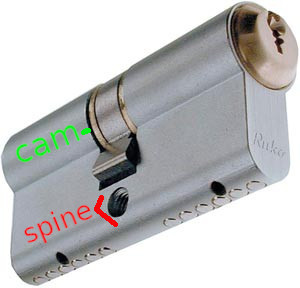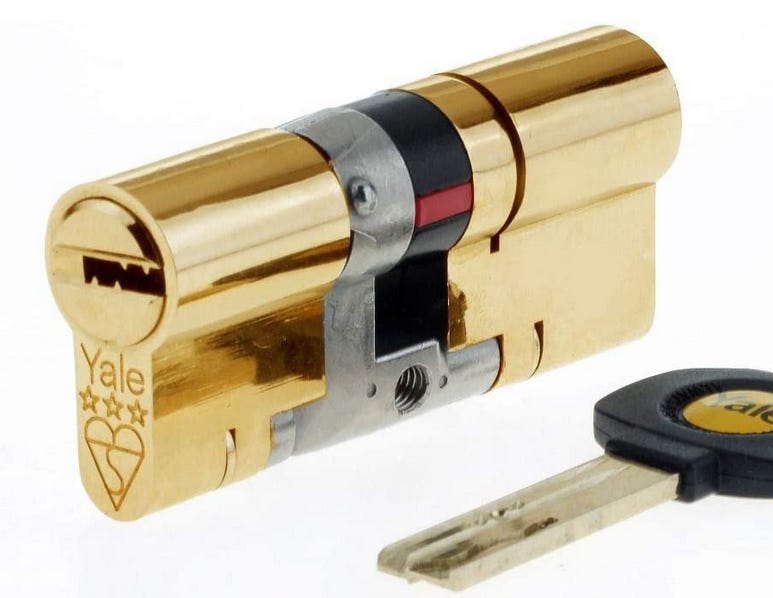I have had several requests to go into detail on how to actually secure buildings and homes, so in this series i will walk through entry points and methods to better secure your property. This post will focus on the door.
When considering the security of your home, the door is not just an entryway—it's the first line of defense against intruders. But how secure is your door, really? If you're relying on the lock that came installed on your door, or if you've never thought about the length of your strike plate screws, you might be overlooking crucial vulnerabilities. In this blog post, we'll explore robust methods to secure your door, from advanced lock technology to physical reinforcements, culminating in the gold standard of home security.
The Lock
Starting with the lock, the importance of investing in an anti-snap and anti-drill lock cannot be overstated. Most people in Europe will use the common “Euro Cylinder” lock, which allows rapid replacement, but also has a major security flaw in that it can easily be broken even while it it inside the door. This is accomplished either by snapping the lock, which breaks the lock in the middle where the actuator is or drilling the lock.
Unfortunately, both of these methods usually only take about a minute to accomplish, and depending on the goals of the attacker, they then can either replace the lock with one they control for persistence into the building, or simply have full access to your home.
This is where anti drill and anti snap locks come in, as they are specifcally designed to prevent this style of attack. You can read more about this attack here.
Anti-snap locks are engineered to ensure that if the lock is snapped, the mechanism will lock down, preventing the burglar from manipulating the lock to open the door. Similarly, anti-drill locks are manufactured with hardened steel plates that dull drill bits, making it exceedingly difficult for an intruder to drill through the lock.
The lock on the left would be easy to snap because it sticks out enough for an attacker to grab onto and snap. The lock on the right cannot be easily grabbed, and therefore would be very difficult to snap, but it could easily be drilled.
Door Hanging
The first point needs to be that the door is fitted properly and swings inward towards the inside of the home and not externally.
The fitting of the door will prevent things like gaps at the bottom which could allow things like under door tools to be used in some cases, or on the sides which allow an attacker access to the latch and deadbolt.
The door also needs to open inwards to prevent having the hinges on the outside of the door which, if they don’t have hing caps, can easily be popped off and the door opened from the wrong side.
The Strike Plate
Moving on to the door frame, consider the role of the strike plate—the metal plate where the lock bolt slides into the frame. A very long strike plate, combined with very long screws that anchor deeply into the door frame and into the wall structure, can significantly distribute the force of an attempted breach.
Not only does the longer strike plate distribute the load when someone is attempting to kick in your door, but the extra length allows for more screws (anchor points) which equals more security.
Unfortunately most doors strike plates come with exceptionally smal screws that only just hold the strike plate in place and isn’t sufficient when an attacker is attempting to kick in the door.
Wooden doors are particularly vulnerable to poor strike plates, making them very easy to be kicked in
Think of the strike plate length as the difference of wearing normal shoes vs snow shoes when trying to walk through deep snow. The longer the strike plate the more the load is distributed and you are less likely to sink.
In some instances , you may not have the ability to use a long strike plate. in which case, special security strike plates can be used such as the following. The long extruding bits will go far into the wall helping to anchor the plate, but in my experience, this still would not be as secure as a longer strike.
The screws are the anchors that hold the strike plate to the door frame, tiny screws equals a very weak anchor. I wont mention the brand, but this is a common screw shipped with a strike plate
Obviously this is woefully inadequate for protecting your door from being kicked in.
Door Bending
European doors, with their distinctive design that incorporates a bend, sometimes even two bends from the outside to the inside. This isn’t made as a security feature, but to help with insultation, inadvertently provide an added layer of security beyond their energy efficiency benefits.
This unique curvature complicates attempts at shimming or directly accessing the door latch, as the uneven gap created by the bend makes it challenging for tools to navigate and engage with the locking mechanism effectively.
Shimming in this case is where an attacker attempts to slide a thin piece of plastic, or something similar, from the outside to gain access to a latch in order to move it. In doors without a deadlatch or deadbolt this can allow an attacker to quickly gain entry without ever having touched the lock.
Companies such as MultiPick do make devices such as this corkscrew looking device specifically to bypass the European door turn, but as long as you have either a proper deadlatch or deadbolt, this tool is pretty much useless.
Homeowners considering door upgrades or replacements can look to this aspect of European door design as an innovative way to integrate both energy efficiency and increased security into their homes, showcasing the unexpected benefits that can arise from thoughtful design.
On American doors, after market devices such as this would easily be shimmed since you have direct access from the outside. But in Europe, because of the curvature of the door frame, such devices are far more viable because shimming these because a huge pain for two reasons. Its difficult to gain access to them, and you don’t know where they are on the secure side of the door.
However, if you are going to purchase something like the below image, get longer screws and really anchor that thing in place.
The Gold Standard: Solid Steel Doors
For those seeking the pinnacle of home security in regards to secure doors, a solid steel door represents the gold standard. Unlike standard wooden or even fiberglass doors, a solid steel door offers unparalleled resistance to physical attacks. The density and durability of steel mean that would-be intruders would need extreme measures, such as a chainsaw and a considerable amount of time, to breach it—a scenario far beyond the typical burglar's capability or willingness to undertake.
Below is an example of someone who had tried to gain access to a building through a steel door
Here is an example of where police needed to use a chainsaw to get through a UK man’s door.
Here is a fun video of the world’s strongest man attempting to get through various door types with hammers.
Additional Considerations
While focusing on the door itself is crucial, don't overlook the importance of other elements such as the visibility of your door from the street, the lighting around your entryway, and even the psychological deterrents like security system signage. These factors play a significant role in making your home an unattractive target for burglars.
In Conclusion
Securing your home's doors requires a multifaceted approach, combining sophisticated lock technology with physical reinforcements. By understanding the vulnerabilities and implementing the strategies discussed—from anti-snap and anti-drill locks to solid steel doors—you can significantly enhance your home's defense against intruders. Remember, the goal is not just to make it difficult for someone to break in, but to make your home so secure that potential burglars think twice before even attempting. In the realm of home security, being proactive is always better than being reactive.
Training Resources:
For individuals looking for a hands on training that includes all of the above topics, Covert Access Team (covertaccessteam.com) provides training courses focused on physical penetration testing, lockpicking, bypassing techniques, social engineering and other essential skills.
Covert Access Training - 5 day hands on course designed to train individuals and groups to become Covert Entry Specialists
Elicitation Toolbox Course - 2 day course of that primarily focuses on elicitation and social engineering as critical aspects of Black Teaming
Cyber Bootcamp for Black Teams - 2 day course designed explicitly for physical penetration testers who need vital cyber skills to add to their toolbox.




















